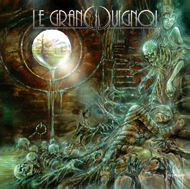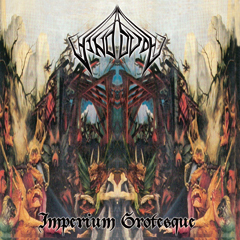 "The Great Maddening" - CD |
|
THOUGHTS OF METAL LE GRAND GUIGNOL, formerly known as DREGOTH, then VINDSVAL, hails from Luxembourg and were formed back in 1996. Catalogued under Symphonic Extreme Metal, most members have gained experience, or still do so, in bands like FALKENBACH, ISENHEIM, ORDO DRACONIS, ABSTRACT RAPTURE, RIVENDELL, and others. In other words: they know their Metal. With VINDSVAL the guys wanted to do something special: preserving the harshness of extreme metal, yet adding wickedly catchy tunes, symptomizing in deep-felt emotions and thus creating gloomy atmospheres, which the band refers to as "grotesque metal". A first result is their (re-released) debut "Imperium Grotesque" (1999). But when opting for a specific course, a name change had to happen and thus LE GRAND GUIGNOL was born in 2006. Early this year the band signed with Maddening Media and the first album has been out since the 24th of August under the title "The Great Maddening" with cover art by the Belgian artist Kris Verwimp (MANEGARM, THYRFING, CROM, SUIDAKRA, ...). Just like its namesake (a French genre-theatre around the blade-crossing of the 19th and 20th century), LE GRAND GUIGNOL are ready to rise the curtain in order to let the public partake in their enrapturing tales of madness. The mastering of the album was done at Galaxy Studios in Belgium, who also worked for bands like MANOWAR, RAMMSTEIN, RHAPSODY (OF FIRE), and many others. It's not easy to comment on/discuss each song as the band has put a lot of diversity in the majority of the 11 tracks. "Cirqus L." is a bombastic, orchestral track serving as introduction to the play, since that's how this album should be seen: a play, but without the visuals. It's up to the listener to imagine what's going on. If you've heard one or both parts of MANTICORA's "The Black Circus", you sort of know how "Cirqus L." sounds. "Degenesis (Amor & Seuche)" clocks in just before 9 minutes and offers a nice mix of harsh vocals, great orchestrations, very diverse melodies coming from the keyboards (be it a piano, an accordion, violin, ...), heavy riffs, different kinds of drumming (metal, folkish, ...), topped with a sauce of pure madness, as found on other tracks too. The diversity also comes out via the different parts of the song: you get an introduction with horses arriving, the heaviness kicks in and right when you think this is the course for a certain time, all this falls away for something more peaceful, brought by the piano and bird samples. After this 'down' moment, it's back to before. And so the flow of the song goes up and down, with each part interlocking flawlessly with the next, presenting you the various stages in the play. Orchestrations play a big role and the violin and piano even more in "Dimension: Canvas", where the atmosphere is a quite mysterious. The vocal parts make this play even more alive, be it harsh, clean or screamy. The many side-steps are just amazingly implemented: a heavy part, a softer one (flute, violin), something atmospheric and then plunging into a dramatic piece. The guitar helps to make the song fuller. The result is very well-executed and very Progressive. The heavier parts, where the piano defines the melody, remind of the "Nexus Polaris" album from COVENANT. "Mens Insana In Corpore Insano" starts with a ghostly, sighing sung part, backed by a music box and orchestral elements., as if the person has really gone mad. Looking at the title, it's only logical. Slowly the tension is being built, before total madness breaks loose through the guitar and violin. This song has moments that remind of the theatrical songs of LACRIMOSA. Tillo Wolf should have made a guest appearance here. ;-) Heavy parts are perfectly interwined with symphonic, operatic pieces. This is pure theatrical Metal and the music box from the beginning is still here. Lots of crazy laughter and a Japanese-sounding musicbox form the start of "Madness And Her Young". Female operatic vocals set in the backing vocals, as Philip screams his lungs out. The basic symphony meets Metal reminds a bit of RHAPSODY's "Dawn Of Victory" album (2000), but we're not dealing with a Power Metal album here. Next to the screaming, Philip also goes for an operatic-like approach, going slightly dement. An organ is added to stress the gloominess of the atmosphere. The drumming is always a key element in Progressive Metal, as the pattern changes many times. Here too, Michel has his hands and feet full changing tempo, grooves, one or double kickdrumming and more. Another top job. "The Healing Process" starts accoustically and its first part is even very peaceful/relaxing. Soon enough the tempo goes up and Symphonic Death/Black Metal takes over. After the Progressive tracks, it's time for something more normal, so to speak, although the Luxembourgians made sure the song would be monotonous. Around the third minute there's a trumpet break to pave the way for the solo, which bursts loose in a maniacal manner. ""Finis Coronat Opus" gets built up very slowly: a soft, operatic piece and a hapsychord, heaviness kicking in and then it's power all the way. Shrieks during the verses, female operatic vocals in between and even a few spoken female parts. An accoustic break serves to let the story-telling come through, before the rest of the song takes over. Fast drumming with double kicks, shrieky vocals and chugga-riffs are the ingredients for "I, Who Brought Forth Myself". Another 'normal song, with here the violin and flute being the spices that make this song more attractive and interesting. Without these two elements, it would be pretty standard stuff, although there's nothing wrong with that. A Celtic/Folkish with orchestral support intro for "Alsuntia". All instrumental and in the vein of the latest SUMMONING works. This song actually forms the intro to "Lucilinburhuc", which has the same basis, but then with the guitars and blastbeating drums making it Metal. Later in the song, a Folkish singing moment follows. Here too, the trumpets play a vital role. Add the shrieky vocals and you can obviously again refer to SUMMONING, to name one example, since SUMMONING is still quite different, but there are tangent places. "In, Beyond Or Through" ends the mad play. It's not even two minutes long, so you could, in a way, consider it an outro. Fully instrumental, like "Alsuntia", but the orchestral aspect dominates all the way through, although it does get assistance from the guitars and drums in the last tens of seconds. A very outro, even if more could be done with it. The band members themselves call their music Grotesque Metal, but you could just call it Theatrical Metal. Ok, easier put: take HAGGARD, LACRIMOSA, THERION, DIMMU BORGIR (or any other similar band), a sniff of Power Metal, a bit of Folk (e.g. FALKENBACH). Blend it all together and you should come pretty close to what LE GRAND GUIGNOL has accomplished with "The Great Maddening". Symphony meets Extreme Metal, prefectly composed and executed. You have to take your time with this album, since you won't hear it all the first time. Once you're drawn into this 'play', this musical piece of theater, the transition to the real world won't be so easy. Very recommended material, to say the least. |
|
